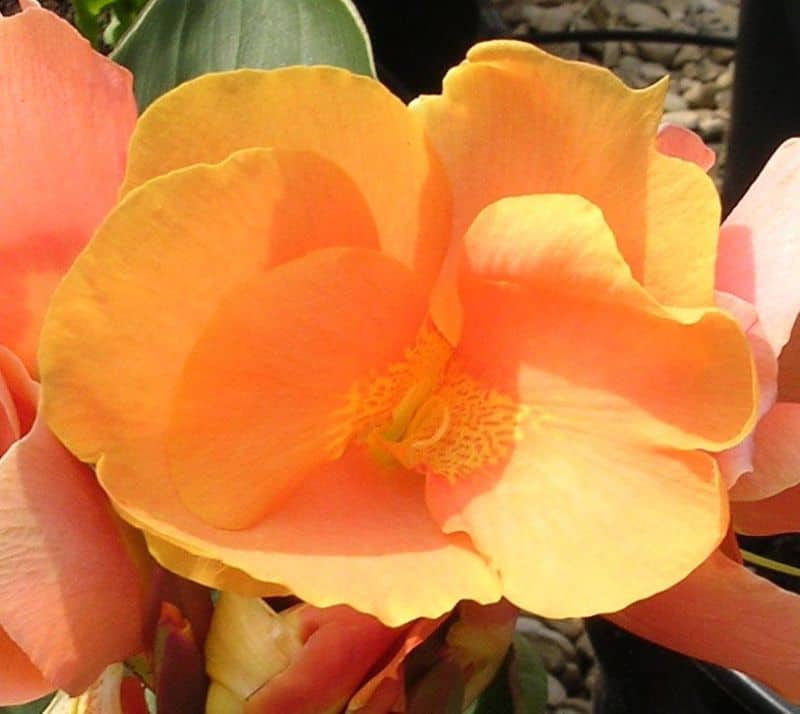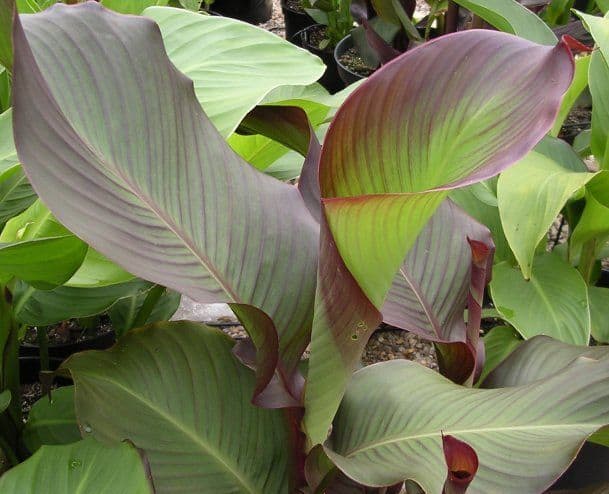What if you could grow a garden that was not only beautiful – but edible, too?
One of my major gardening goals for this year was to reduce as many of my “non-purposeful” gardening tasks as possible. Last year, I found myself doing a lot of weeding, mowing, and watering for areas that weren’t really giving me anything in return.

Sure, a nice lawn and a pretty flower bed are fun to look at, but that’s about it.
I enjoy having a property that looks attractive as much as the next person, but when you get busy, it’s hard to justify spending the time on areas that don’t give you anything in return.
There are all kinds of flowers you can grow that are not only pretty, but some are also edible. The edible canna lily is just one example.
Here’s everything you need to know about this ornamental, edible bloom.
What is Edible Canna?
In the ancient Peruvian diet, canna lilies were a significant source of nutrients. Unfortunately, this food has fallen out of use in that part of the world, as well as everywhere else.
In North America, canna lilies are rarely grown for consumption. Instead, they are cultivated for ornamental purposes. However, in southeast Asia, particularly in Vietnam, this plant is used to make things like cellophane noodles. Here, the roots are grated then rinsed, or else they are boiled until they are soft.
There are several kinds of canna lilies, but out of all of them, only Canna edulis can be used as a food. Also known as canna indica, this plant is known by many other names, including achira and Queensland arrowroot.
Besides that, there are more than 20 other kinds of canna lilies (some say up to 100) around the world.
All canna, including edible canna lilies, have ornamental flowers and tropical-looking foliage that is similar to that of a banana. In fact, the two are actually close relatives. They produce large rhizomes (up to a foot or more in length!) which make them valuable as a food source.

Now here’s a shocking fact – canna lilies aren’t actually lilies! As I mentioned, they are members of the banana family, so the lily name is a bit of a misnomer, probably attributed to the plant because it does look quite a bit like a lily when it’s in full bloom.
The canna lily belongs to the order of Zingiberales, the same family as bananas and ginger. The canna lily produces large green leaves that are sometimes variegated or a deeper maroon color. The blossom color on these flowers can vary but is often red, yellow, orange, or multicolored.
Canna lilies aren’t fond of frost, but do often come back after freezing to the ground. Make sure you don’t consume edible canna lilies with calla lilies – these plants are toxic. Be really careful when selecting which canna variety you want to grow, and know for sure whether or not you can eat it!
You can eat the blooms and the roots of the plants, although the roots are the most commonly harvested. The roots are fibrous and starchy, best steamed and eaten after being fully cooked. The leaves are a lot like lettuce, and are crisp and crunchy.
How to Grow Canna Lilies
If you’re interested in growing your own canna lilies, don’t worry! It’s easy to do. These plants can be grown year-round if you live in a first-free region, or, if you’re like me in a cold growing ozone, they can be grown in a greenhouse or some other protected indoor area.
If you grow canna lilies in a frost-prone region, you’ll find that these stalks and foliage die back each winter, with new regrowth appearing in the spring. You can leave the rhizomes in the ground throughout the year, as the freeze will not kill them.
Canna lilies can be grown in light shade or full sun, making them versatile plants. They prefer soil that is wt and clay-like. In fact, these plants are some of the best if you have damp soil that remains waterlogged much of the time.
Propagating and Planting Canna Lilies
Propagating canna lilies so you can grow your own is simple. All you need to do is chop a clump off the plant and divide what you want, planting the rest elsewhere. The roots will produce a large mat over time. You can harvest whatever you’d like.
You are best planting canna lilies from these propagations or tubers. You can plant them from seed, too, but this will take much longer and can be quite challenging.
If you grow lilies in an area that is prone to freezing, you will want to put your lilies in the ground first thing in the spring or early summer.
If you are growing in a milder region, you can wait. They can be planted at just about any time throughout the year.
To plant, put the tubers about two or three inches deep in the ground. Make sure they are spaced roughly 12 inches apart.
If you don’t have dormant tubers, you can also plant lilies that are actively growing. The bottom of the fleshy stalk should be right at the soil line.
Finally, as I mentioned, you can also plant seeds. To do this, you will want to look for spiky seed pods that appear on the plant once the flowers fade back.

As the pods dry, they will split open, revealing brown or black seeds. They are hard and remain viable for quite some time.
You will need to soak the seeds for a couple of days. They will swell up, provided that you nick the seed with a pair of clippers before soaking. They’ll germinate in about a week after you plant them in the ground.
Once you get the seeds going – the challenging part – the plants grow rapidly and can be transplanted directly into the ground after a month or so.
Caring for Canna Lilies
Try to provide your canna lilies with a minimum of an inch of water each week during the growing season. This can be done via manual watering or with natural rainfall – just make sure you provide plenty of water if it hasn’t rained in a while.
You don’t have to fertilize, but it can help your plant grow faster. You can fertilize anytime during the growing season, from spring until fall.
Use some kind of balanced fertilizer that is safe for use on edible crops – that’s the main difference between growing these flowers as edible crops versus strictly as ornamentals.
Pests and Diseases
For the most part, frustrating pests leave canna lilies alone. The only things you’ll have to watch out for are slugs and caterpillars.
These tend to damage the leaves of canna lilies but can be destroyed by hand-picking them from the plant, and dropping them in a bucket of soapy water, which should kill them.
There are very few diseases to which this beautiful, delicious plant is prone, too.
Growing Canna Lilies in Containers
You can even grow canna lilies in containers! To do this, just make sure you have potting soil that will hold moisture well, while at the same time being relatively well-draining. The ideal container size for an canna lily is a pot with a 12-inch diameter.
When growing in a container, keep in mind that you may have to fertilize more often. You also will want to make sure you’re not fertilizing during the plant’s dormant period, during the winter, which is easy to forget when you move your container of canna lilies indoors.
Harvesting and Using Edible Canna Lilies
The edible part of the canna lily is the root. You will want to harvest fresh shoots first thing in the spring. These can be used on stir-fries and salads.
When you harvest, wait to do so until about six months after planting (or as long as ten months). The longer the roots are in the soil, the larger they will get – although after ten months, they can develop a woody texture and flavor.
You can cut the stalks right at the soil line, and then dig the roots. The rhizomes can be baked or boiled – let them turn from white to somewhat translucent.
Unfortunately, canna root, unlike other root crops, does not store well. You should leave it in the ground until you are ready to use it (ideally within a few days). It can be eaten boiled or raw, but I recommend cooking it by baking it for quite some time.
You do not need to peel the roots but you should bake them long and slow. In Peru, the roots of this plant were once cooked for a minimum of 12 hours!
Other Uses for Canna Lilies
Besides just looking at them and eating them, canna lilies offer several other uses, too.
If you live somewhere in which canna lilies can be grown year-round, consider cultivating them and using them as a garden windbreak. They’ll help keep harsh, eroding winds off your more sensitive plants.
They can also create a sun-shade for plants that are more sensitive to the heat in the summertime or serve as a terrace to prevent mulch, water, and soil from eroding.
I’ve even heard of canna lilies being used to form a weed barrier! These plants grow so densely and thickly that it makes a lot of sense to plant them somewhere you don’t want weeds to sprout.
Canna lilies can also be used as a living fence, helping to keep chickens and other animals out of your garden. Since they grow so tall, your chickens aren’t likely to hop over.
For whatever reason, I haven’t heard of chickens being tempted to nibble on canna lilies, either – which is unusual, given that chickens seem to eat just about everything!
However, if you cut the canna lilies first, your chickens will probably be happy to eat them. Go figure!
Finally, canna lilies can produce exceptional amounts of organic matter for your garden. Growing canna lilies and then chopping the vegetation down when you’re ready to harvest the roots is a great way to add nutrients and fertility back to the soil.
You can even add the uneaten portions of the plant to your compost (although just about all of the plant can be eaten).
Consider Growing Canna Lilies
With all of these uses for canna lilies, it’s surprising that more gardeners aren’t growing them in their backyard gardens. On my quest for a more self-sustaining, purposeful landscape, it’s definitely a plant I’m going to consider growing!


Rebekah is a high-school English teacher n New York, where she lives on a 22 acre homestead. She raises and grows chickens, bees, and veggies such as zucchini (among other things).
